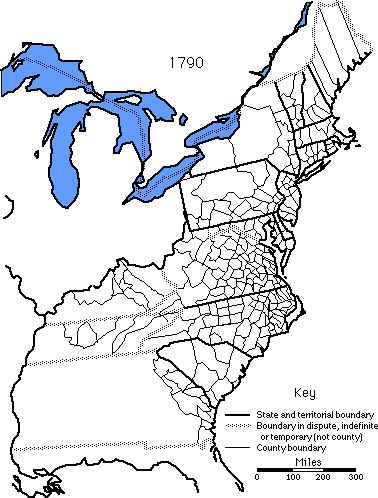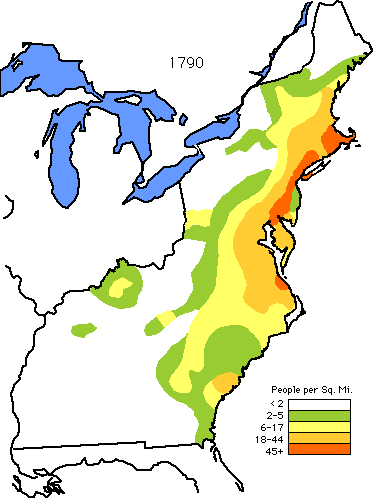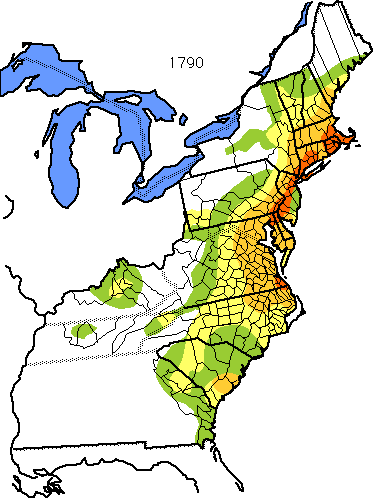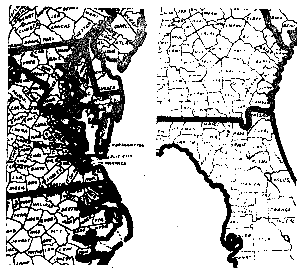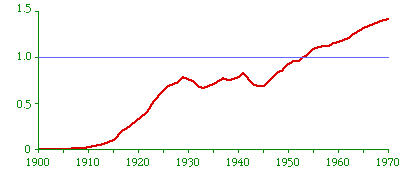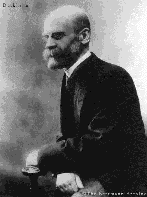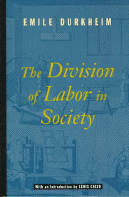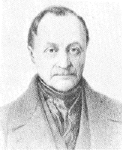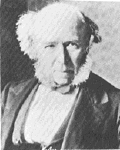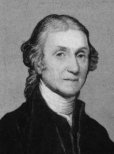CHAPTER 4
Testing the Model
While browsing in the genealogy section of the library I happened to
find a work showing all United States county boundaries for 1790 (see
Fig. 4-1), similar to the set mentioned in Chapter 2 showing the
boundaries for each of the thirteen original states[1]. In addition to adding boundaries for
Kentucky and Tennessee, there was a dot map showing population
distribution.[2] It was evident from this
pair of maps that, in 1790 at least, the size of counties was strongly
related to the distribution of population, in accordance with the model
proposed in the last chapter.
The dot map did not reproduce well, but the same information can be shown with a map showing population densities. In Fig. 4-2 I have reproduced one adapted from an historical atlas and set to the same base map as Fig. 4-1. The original showed fairly fine gradations for densities per square mile (6-18, 18-45, 45-90, 90 and over). All I needed to demonstrate the relation between settlement area and county size, however, was the more limited information shown in Fig. 4-3: Regions of little or no settlement have very large counties; older, settled regions show smaller counties.
About this time I received further communication from the Census Bureau. The Chief of the Geography Division said he had located a set of historical maps stored in a closet in the Agriculture Department (the Bureau was in the Department of Commerce). The maps were large and more like sketches for cartographic work than finished maps. They indicated no authorship. They began with the census year 1890 and went back as far as 1840.
Given the population distribution maps from the historical atlases, and the county boundary maps for 1790, 1840-1890 and the present (and a new set[6] produced long after this research was completed), it is obvious that the process of county subdivision took place as described by the model in the preceding chapter. The cessation of further subdivision with the introduction of the automobile lends further support to the model. Fig. 4-4 shows the number of automobile registrations per household in the United States, from 1900 to 1970. By 1930 the number of cars per household was at the level it was to retain until about 1950, with most of the growth occurring during the 1920s. That is also the period in which county subdivision came to an end (see Table 2-1).
Since the introduction of the automobile there has been more talk of county consolidation than further division.[8] Georgia consolidated three counties into one after 1930 (see Table 2-1). Connecticut and Rhode Island have abolished the county as a unit of local government[9], in effect consolidating at the state level. Transportation technology, in the form of the school bus, led to school district consolidation (from 140,000 districts to 50,000 between 1947 and 1957) and the car to consolidation of rural churches (20,000 of which disappeared between 1930 and 1950).[10] Other than the few exceptions just indicated, county consolidation has remained mostly talk. The 3,000+ horse-and-buggy units of government, with all their attendant officials and costs, persist. SOCIOLOGY & COUNTY SUBDIVISION My original question about variation in county size now appeared to have been answered. The size of counties was a function of the technology of transportation at the time they were settled. Intensive settlement, prior to the automobile, resulted in smaller counties; less intensive settlement left large counties unsubdivided.
In that work Durkheim identified two fundamental types of social organization, the "segmental type" and the "organized type". The segmental type consists of a "system of segments homogeneous and similar to each other"[13]. There were two subtypes: those based on consanguineous groupings (e.g., clans, tribes) and those based on upon territorial units (e.g., counties, provinces). Durkheim's interest, however, lay with the latter: The bulk of the population is no longer divided according to relations of consanguinity, real or fictive, but according to the division of territory. The segments are no longer familial aggregates, but territorial circumscriptions.[14]The primary argument of Durkheim's book is that this system of territorial divisions is gradually being replaced by the "organized type", based on the division of labor: It is a general law that partial aggregates which participate in a larger aggregate see their individuality becoming less and less distinct.[16]The reason for this is that functions originally carried out within the partial aggregates begin to be carried out at the level of the larger aggregate, under pressure of competition. In the process each of the functions becomes more specialized as the reoriented set of functions becomes more interdependent. Territorial divisions are thus less and less grounded in the nature of things, and consequently, lose their significance.[17]The end result of this process is the organized type, constituted not by a repetition of similar, homogeneous segments, but by a system of different organs, each of which has a special role, and which are themselves formed of differentiated parts.[18]The "progressive preponderance of organic solidarity" results in and from the "effacement of the segmental type". Social change thus consists essentially of an increased division of labor with greater functional interdependence as territorial divisions become increasingly artificial. Durkheim's explanation of these historical processes is given in Book II of his work. Increase in the division of labor was due, he argued, to either or both of two conditions: (1) increased population density and (2) improvement in the technology of transportation or communication. Either of these tends toward an increase in social interaction, including competition, which in turn may result in more specialization and division of labor, i.e., effacement of the segmental type. The model developed in the last chapter explains increased division of territory in related, though opposite, terms: expansion of the settlement area (rather than increased density) under constant transportation technology.
Perhaps Sociology fears irrelevance if it should acknowledge three established disciplines as masters of Comte's three stages:
I don't see why Sociology can't take as its special focus the relating of these fairly specialized areas, within the context of geographical and historical frameworks. Publication of the Findings The dissertation work began in the Fall of 1968. The proposal was approved by the committee June 3, 1969, and the final version, titled "Variation in County Size: An Historical and Ecological Explanation", was accepted February 13, 1970. I took a position as Assistant Professor beginning the following Summer quarter in the Department of Sociology/Anthropology, Western Washington State College (now Western Washington University) in Bellingham. In the Fall of 1970 I wrote the dissertation research as a brief paper for submission to the American Sociological Review. I retained the narrative sequence of the dissertation itself: reviewing the initial size-distance relation which failed, next the size-type failure, then the recognition that county size was the result of an historical process of subdivision, and finally the connection between that process and the dual factors of population distribution and transportation technology. In the conclusion I criticized Durkheim's beliefs in the light of these findings. The editors returned the paper with two suggestions for revision. First, they found the report of the failed efforts unnecessary: Who cares what didn't work? Second, and related to the first, why not derive the hypothesis from Durkheim's work, toss in the Boulding-Stinchcombe language, and present my findings as a test of Durkheim? What they wanted, of course, was the standard article format: review of the literature → derivation of hypothesis → test of the hypothesis → conclusion. That structure makes sense, it seems to me, in a well-developed research area. It permits the reader to quickly fit one's work into the existing body of literature. In a relatively undeveloped field, however, I think it does harm. It pretends consensus and structure where there is none. The "relevant literature" tends to be more a matter of fad than established knowledge. More importantly, I think it robs the work of interest for the reader. My work on county subdivision was interesting (to me) because I did not have the answers in advance or any guidance from "the literature". I wasn't testing anyone's hypothesis. In fact, had I suspected at the outset what I later learned, I probably wouldn't have bothered with the study; I wasn't at that time very interested in demography, transport technology or local government. It was the failure of those early, and I thought reasonable, hypotheses which egged me on. In defense of my negative view of scholarship's role in science (as opposed to plain old curiosity, which needs no defense) I quote Priestley[21]. The quote recounts his unanticipated discovery of the fact that the process of combustion, rather than removing "phlogiston" from a substance, actually adds oxygen to it: All this aside, new assistant professors don't set the rules for the ASR. I completed the requested revisions (even changing the sub-title to reflect Durkheim's "influence") and submitted the revised paper. The published article [22] lacked, I think, the sense of curiosity, excitement, frustration and pleasure which the research itself had given me. By the time I had written and re-written the dissertation and written and re-written the paper, I was less interested in its fate than I was in new research already underway. My father's reaction to this article was brief: "Playboy has nothing to fear from the ASR." My department's was peculiar: whereas in graduate school (Univ. of Oregon) publication in the ASR usually meant promotion for the faculty member, my colleagues at Western Washington State College greeted this accomplishment with the suggestion that I should look elsewhere for a job (the department was not very oriented toward research and publication; they made a greater fuss the week before over another colleague's having landed a large red snapper out in Puget Sound).
NOTES: [1] W. S. Rossiter, A Century of Population Growth: From the First to the Twelfth Census of the United States, 1790- 1900. Washington, D.C.: Government Printing Office [2] Herman B. Friis, A Series of Population Maps of the Colonies and the United States, 1625-1790, Figure 12, New York: American Geographical Society. 1968. [3] adapted from Herman B. Friis, Op. Cit. Figure 11. [4] adapted from Charles O. Paullin. Atlas of the Historical Geography of the United States, Plate 76B, New York: American Geographical Society. 1932. [5] Paullin's Atlas showed population density maps for 1790 to 1930. He did not show the west for 1850 or 1860. For these I substituted another atlas: Clifford L. and Elizabeth H. Lord. Historical Atlas of the United States (rev. ed.). New York: Henry Holt and Company, 1953. [6] William Thorndale and William Dollarhide Map Guide to the U.S. Federal Censuses, 1790-1920 Baltimore: Genealogical Publishing Co., Inc, 1987. [7] computed from Bureau of the Census, Historical Statistics of the United States, Colonial Times to 1970. Washington, D.C., 1975. Series A-350 (Total Households) and Series Q-153 (Automobile Registrations). Note: automobiles for 1943 are given as 36,009. This appears to be erroneous given the total vehicles figure; I have changed it to 26,009 for the computations presented here. [8] see, for examples, Henry Stimson Gilbertson, The County, The "Dark Continent" of American Politics. New York: The National Short Ballot Organization, 1917; Albert Ogden Porter, County Government in Virginia: A Legislative History, 1607-1904, 287-307, New York: Columbia University Press, 1922; Wylie Kilpatrick, Problems in Contemporary County government, Charlottesville: University Press of Virginia, 1930:ix-x; Arthur M. Bromage, American County Government, 190-232 New York: Sears Publishing Company, 1933; Lane W. Lancaster, Government in Rural America, 382-410 New York: D. Van Nostrand Company, 1937; William Anderson, The Units of Government in the United States: an Enumeration and Analysis. 44-47, Chicago: Public Administration Service,, 1945; Paul Woodford Wager, County government Across the Nation. 31-33, Chapel Hill: University of North Carolina Press, 1950; Everett M. Rogers, Social Change in Rural Society, 393-4, New York: Appleton-Century-Crofts, 1960. [9] Bureau of the Census, Census of Governments, 15, Washington, D.C., 1967 [10] Rogers, Op.Cit., pages 212 and 235. [11] Professor Anderson had moved on the University of Minnesota prior to the dissertation defense. The committee consisted of Professors Benton Johnson (Chairman), Walter T. Martin, and Roland Pellegrin from Sociology, with Joe Allman from Political Science representing the Graduate School [12] Emile Durkheim. The Division of Labor in Society. Translated by George Simpson. Glencoe: The Free Press. 1964(1893). [13] ibid., 181. [14] ibid., 185. [15] ibid., 186. [16] ibid., 187. [17] ibid., 187. [18] ibid., 187. [19] Auguste Comte. The Positive Philosophy. edited and translated by Harriet Martineau. New York: AMS Press. 1974 (1830-42). [20] Herbert Spencer. The Principles of Sociology. 3rd edition, 3 vols. New York: D. Appleton and Company. 1898(1876-97). [21] Joseph Priestley, "An Account of the Discovery of Dephlogisticated Air, and its General Properties", Experiments and Observations on Different Kinds of Air and other Branches of Natural Philosophy, Connected with the Subject (3 vols),, Vol. II, Bk IV, Pt I, Sec 1, p. 102 Birmingham, 1790. quoted more extensively in Peter Wolff, Breakthroughs in Chemistry, New York: The New American Library, 1967. [22] G. Edward Stephan. "Variation in County Size: a Theory of Segmental Growth." American Sociological Review, 36:451-61. | ||||||||||||||||||||||||||||||||||||||||||||||||||||||||||
